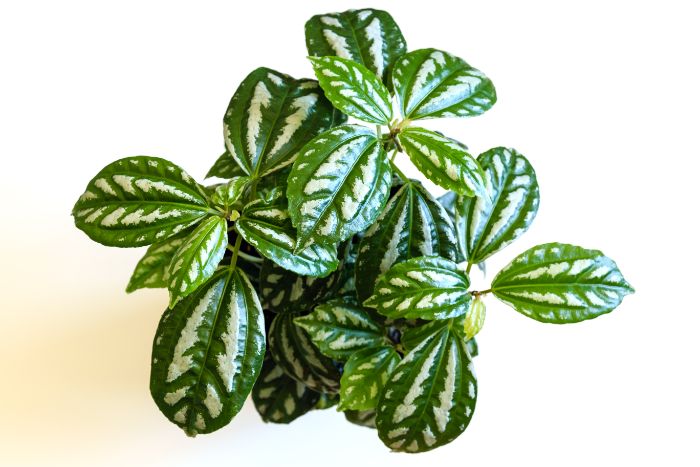When it comes to an Aluminum plant (Pilea cadierei), it is all about the beautiful silvery sheen of the foliage. When provided good growing conditions, it’s an easy to grow houseplant and the colorful foliage will certainly dress up indoor areas. Let’s start with a quick summary of their care.
How to care for an Aluminum Plant (Pilea cadierei): To keep your Aluminum plant thriving and healthy, grow in well-drained soil and water when the top 1/2 inch to inch becomes dry. Maintain indoor temperatures between 60°F to 75°F, create a humid environment, fertilize every two to four weeks, and situate in bright, indirect light.
Continue reading for all the basics of good care and helpful tips to keep your Aluminum plant thriving for years to come.
Aluminum Plant Care (Pilea cadierei)
Native to the warm and humid, frost-free regions of Vietnam and China, Aluminum plants are members of the nettle family Urticaceae. Considered a tender, herbaceous, evergreen perennial, only those who live in the warmest regions can grow it as an outdoor plant.
However, those living in cooler temperate regions can grow Aluminum plant as a houseplant or potted outdoor plant and bring indoors to a protected location during winter. Outdoors it is only hardy to 59°F. It gained the Award of Garden Merit from the Royal Horticultural Society.
Aluminum plant gets its common name from the silvery splashes on its green and oval toothed foliage. Each leaf has four raised silvery streaks across the top. The coloration of the leaves also gives the plant another common name, Watermelon Pilea. Each leaf is around 2- to 4-inches long.
Although Aluminum plants do produce flowers, they are small and barely noticeable against the elaborately colored leaves. During summertime, small greenish-white flowers form at the tips of each stem. However, blooms are less common when plants are grown indoors year-round.
In addition, plants have a moderate rate of growth with a spreading habit, growing around .50 to 1 foot tall and .50 to .75 inches wide. A dwarf variety, ‘Minimia’ tops out around 6 inches tall with half-sized leaves.
Provided an Aluminum plant receives proper light, humidity and water, it is the perfect houseplant for the novice, as its maintenance requirements are relatively low.
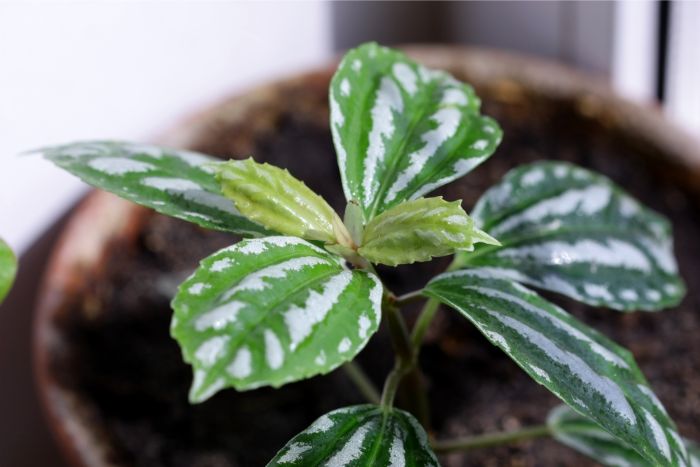
Soil Conditions
The best soil for growing an Aluminum plant is one that drains well and has a peaty base. It performs well in a rich soil medium provided it drains and does not remain soggy.
Many commercial potting mixes work well and some even have the addition of a slow-release fertilizer, cutting down on the need for frequent feedings.
Many times, straight potting soils are too heavy and do not adequately drain, but they are OK to use if your cut the mixture with something like peat, coarse sand or a lightweight potting mix.
Just use equal portions of each in your mixture to add proper drainage. If the soil remains too wet for too long, root rot can develop which will kill your Aluminum plant.
Aluminum Plant Light Conditions
When situated outdoors, Aluminum plant grows best in a location that receives partial shade, as it will not tolerate being in full sun and the leaves can scorch.
Indoor grown plants prefer a location that receives bright, indirect light for at least four hours each day. Even indoors, don’t allow it to sit in a location receiving direct sunlight or the foliage turns brown due to burning.
On the other hand, don’t place it in an indoor location that is relatively dark and does not receive enough light or the stems become gangly and the plant will not perform well.
Temperature Requirements
In its native habitat, Aluminum plants thrive in the consistently warm and humid conditions.
When grown indoors, Aluminum Plants prefer temperatures that range between 60°F and 75°F. If it is comfortable for you indoors, it is more than likely comfortable for the Aluminum plant.
In addition, it will also tolerate short bursts of temperatures that are a bit lower and higher. If for some reason you gave your plant a break from indoor growth and set it outdoors, just remember to bring it back indoors before the cold temperatures of winter come knocking on the door.
How To Water An Aluminum Plant
Although Aluminum plants prefer the soil to be slightly moist, this does not mean sopping wet or the plant will develop rot and die. During the growing season of spring throughout summer, stick your finger into the soil and if the top 1/2 inch to inch feels dry to the touch, apply water until it runs from the bottom drain holes.
During fall and winter when the Aluminum plant goes through a dormant period and growth slows, water when the top couple of inches of soil feel dry to the touch. The plant’s water requirements are lower while it goes through dormancy.
When it comes to the best type of water to use:
- Allow faucet water to sit out overnight before using.
- Water using collected rainwater.
- Use room temperature water and not cold.
Do not allow the plant to sit in water after it drains from the pot’s bottom drain holes. After watering, allow the soil to drain completely for around five minutes and then empty the bottom tray. If the container is allowed to sit in water, it opens the Aluminum plant up to developing problems with rot.
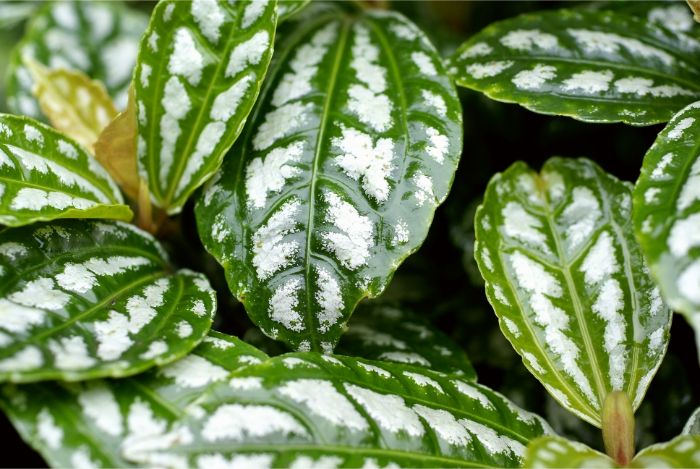
Humidity Requirements
Within its native range, Aluminum plants receive a constant supply of humidity, which needs to be replicated inside the home. If the plants do not receive the proper levels of humidity, leaf tips can turn brown. However, giving the plant adequate amounts of humidity while it resides indoors is basic:
- Set the container on a tray of pebbles and as the container drains into the pebbles and the water evaporates it creates a humid environment around the Aluminum plant.
- Using room temperature rainwater or faucet water allowed to sit out overnight, mist the Aluminum plant’s foliage several time weekly. As an extra bonus, this also helps wash off any dust as it begins accumulating on the leaves.
- If conditions are bright enough, situate the Aluminum plant in a bathroom where the constant use of water creates humidity.
Don’t plant the Aluminum plant in an indoor location that is drying like near a heating or air conditioning vent.
I’ve got a few tips and tricks for improving humidity for indoor plants that can help you get the perfect conditions for your Aluminum Plant.
How To Fertilize An Aluminum Plant
To promote dense growth, fertilize Aluminum plants every two to four weeks during the growing season of spring throughout summer. During fall and winter while the plant is no longer actively growing and dormant, cease all feedings until spring returns.
If your potting mix contained a slow-release fertilizer, then you probably will not have to feed again for around three months. Most slow-release blends continue feeding the plant for around 12 weeks.
Otherwise, use a water-soluble houseplant fertilizer applied at 1/2 strength. You can apply the fertilizer when you typically water, allowing it to run through the soil and out the bottom drain holes. If you use too strong of a fertilizer blend you can end up burning the Aluminum plant’s foliage.
To flush any buildup of fertilizer salts from the soil, flush it out with water around every three to four months. This is as easy as taking the pot to the sink and allowing water to slowing run through the soil.
Pruning Requirements
To keep your Aluminum plant looking its best and to continue promoting dense growth, in springtime trim the plant back by half. You can keep any healthy cuttings to propagate new plants. This is a good way to get several years of good growth from the plant. In addition, trim off any dead or damaged foliage or stems throughout the year.
Always use sterilized pruning tools to prune your Aluminum plant so you do not transfer any diseases or pests to the plant. Just wipe the blades off with rubbing alcohol and you are ready to start making your cuts.
Potting Needs
Depending on the size of your Aluminum plant, it will grow well for quite some time in a 6-inch to 8-inch pot, provided it has bottom drainage.
Many times, and after several years of growth, the plant loses its luster and is discarded or new plants are propagated through cuttings. However, with a spring pruning you should be able to get several years of healthy and productive growth out of the plant.
If the root system is filling out the present container, it is time to move the entire plant up to one that is one size larger.
Potting an Aluminum plant is very simple:
- Fill an appropriate sized container with bottom drainage about 1/4 full of a fertile, well-drained potting mix. Water to settle the soil.
- Place the Aluminum plant in the center of the container, handling the succulent-like leaves carefully, and backfill with soil. Do not plant the Aluminum plant any deeper than it was originally growing.
- Firm the soil up around the base of the Aluminum plant and water again and until it runs from the bottom drain holes.
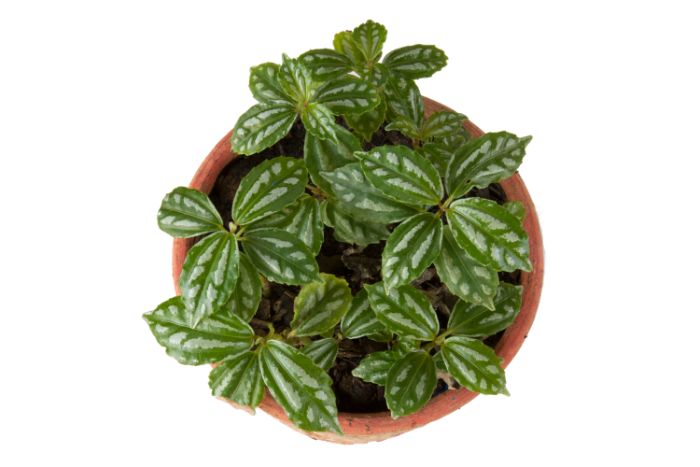
Propagating Aluminum Plants
Aluminum plant’s succulent-like leaves and stems make it easy to propagate through cuttings. Using sanitized pruning tools, snip off a stem that is 4- to 6-inches long.
Pinch off the bottom leaves and place the cutting in a small glass of water or moist potting mix. Do not allow the foliage to be submerged in the water and change the water when it starts looking cloudy. You should start seeing roots develop in around two weeks.
For cuttings started in soil, keep the soil moist but not soggy or rot can develop. The Aluminum plant cuttings should start developing roots in around two weeks and have an established root system in around six to eight weeks. Just be sure the pot has bottom drain holes and you use a well-drained potting mix.
Disease Problems
Overwatering or growing the Aluminum plant in soil that does not drain well and retains too much water causes the biggest disease problems in the plant.
When conditions are too wet, problems such as blight and rot take hold and can quickly kill the plant. They show up as brown or black, rotted looking sections on the leaves and stems.
If caught quickly enough you can prune off the infected sections and allow the soil to dry. If your soil is naturally too wet, repot the Aluminum plant into another soil mixture that drains well. Just make sure the container drains properly.
Prevent the problem from occurring by only watering when the top 1/2 inch to inch of soil becomes dry during the growing season and cut back watering in winter to when the top several inches of soil becomes dry. Use a potting mixture that drains well and make sure the pot has bottom drain holes.
Pest Problems
The two pests you might encounter with an indoor grown Aluminum plant are mealybugs and spider mites. Both types of pests are sap-suckers, meaning they pierce the plant’s stems and leaves with their mouths and suck out its juices.
If left untreated, both of these pests can severely damage or kill your Aluminum plant and in the worst case, travel to your other indoor plants creating even bigger problems.
Identifying both these bothersome pests is easy:
- Spider mites spin a fine webbing over the plant and the tiny white mites can quickly cause damage if left unchecked.
- Mealybugs resemble thick, white cottony masses that develop along the branches and leaves.
You have several methods of controlling an outbreak:
- If you catch a mealybug infestation at its start, you can wipe the pests from the plant using a damp cloth.
- However, for spider mites and larger mealybug outbreaks, use an insecticidal soap or Neem and spray the tops and undersides of foliage, as well as the stems. Mix and repeat the treatment according to package directions.
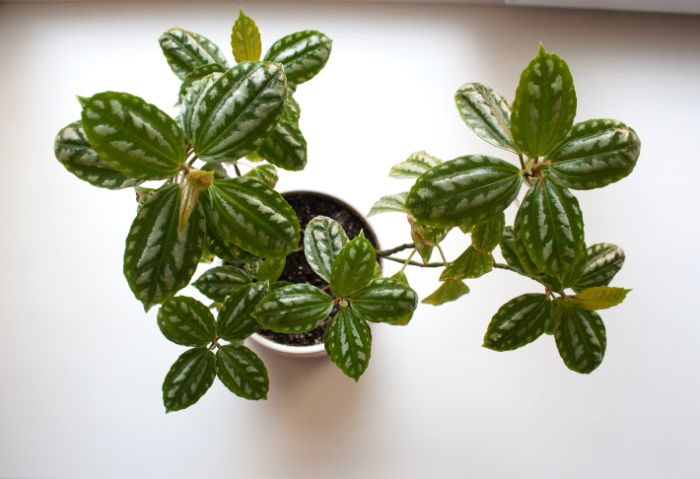
Why Are Parts Of My Aluminum Plant Turning Black And Rotting?
The main cause on why leaves and stems of an Aluminum plant begin turning brown to black and begin rotting are too wet conditions. This can be caused by soil that is too heavy, containers without bottom drainage or watering too much.
Prevent this problem by planting in pots with bottom drain holes, using a well-drained soil mixture and watering during the growing season when the top 1/2 inch to inch of soil becomes dry. In winter, only water when the top several inches become dry.
Why Are My Aluminum Plant’s Leaves Losing Their Color With Browning Tips?
If your Aluminum plant’s leaves start losing their luxurious color and the tips start browning, two things can cause it. The plant might be getting too much direct sunlight, which washes out the coloration on the leaves and the tips brown due to burning.
It can also be caused by indoor conditions that are too cold or there’s a sudden drop in the temperature. Prevent the problem by moving the plant to a location receiving bright, indirect light and maintaining indoor temperatures between 60°F and 75°F.
Can I Grow Aluminum Plant In An Aquarium?
Although sometimes found being sold in a pet store as an aquarium plant, Aluminum plants are not aquatic and will not survive for long submerged underwater. However, if used as an aquarium plant it will live for only two to three months before dying.
Why Are My Aluminum Plant’s Leaves Yellowing And Changing To Brown?
If you notice your Aluminum plant’s foliage starting to yellow and then changing to a crispy brown, the plant is receiving too much direct sunlight. The best course of action is to move the plant to a location that receives bright but indirect light during the day.
Are Aluminum Plants Toxic To Pets?
Some reputable sources say it is and some say it is not, but err on the side of caution and do not allow your pets or children within easy access to the plant.
The Lifespan Of An Indoor Aluminum Plant
When pruned back in springtime, an indoor Aluminum plant typically remains attractive for one to two years, although many people start with a fresh plant each year or root cuttings from the mother plant to create a new plant.
Does An Aluminum Plant Flower?
Indoor grown Aluminum plants rarely flower but if they do, the tiny greenish-white flowers are insignificant, as it is all about the colorful foliage.
How Fast Do Aluminum Plants Grow?
Even when grown indoors, Aluminum plants are considered to grow at a fast rate of speed.
I hope you’ve enjoyed learning how to care for an Aluminum Plant. If you want to learn more about caring for your indoor plants, stick around and check out some of my other articles.
This site is full of useful information to help you grow amazing houseplants that will brighten up your home. See my houseplants section for more.

